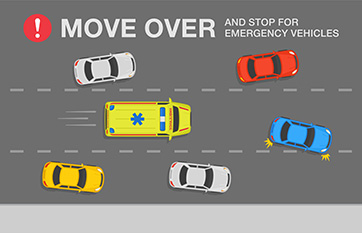
Of course you know that you’re supposed to get out of the way of an emergency vehicle heading toward you fast with swirling lights and sirens blaring, but where do you actually go?
It depends on where you are on the road.

If you are in the right lane, you should pull over to the right as far as you safely can, and stop, so the emergency vehicle(s) can pass on the left. If there is another car to your right, or a different type of obstacle, then the safest thing is to slow down to a stop.
If you are in the left lane, you would pull over as far as you can to the left and stop.
The above is true if you are at an intersection with a stop sign or stop light. Don’t go through the intersection until the emergency vehicle has passed, regardless of which direction the emergency vehicle is coming from. Also, don’t drive through a red light or stop sign. Nor should you try to outrun the emergency vehicle, even if you have a green light.
You also don’t want to speed behind the emergency vehicle as it passes, because there might be another one coming right behind it.
Never just stop in the middle lane without pulling over, if there’s room to pull over. You aren’t trying to make an obstacle course for the emergency vehicle driver.
Regardless of which lane you are in, you need to slow down, try to make room, and stop. An emergency vehicle driver can’t anticipate where to go to get around you if you are still moving.
This is true even if the emergency vehicle is traveling on the opposite side of traffic. Depending on the situation, they may have to travel in opposing lanes. So, don’t just assume you shouldn’t slow down when an emergency vehicle is coming towards you.
Moving out of the way of and stopping for an emergency vehicle will ensure they have the space needed to find a route around you that allows them to arrive at their destination with regard to the safety of others.



